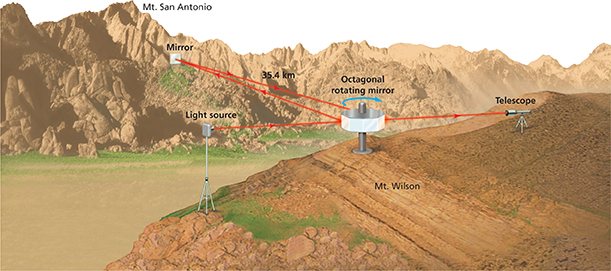The Speed of Electromagnetic Waves
A thunderstorm is approaching. The sky is dark, and lightning flashes in the distance. Within a few seconds, you hear thunder's low rumble. As the storm approaches, the lightning gets brighter and the thunder louder. The lightning flashes and the sound of thunder come closer in time. Still, you see the lightning before you hear the thunder, because light travels faster than sound. But how much faster is light?
Michelson's Experiment
In ancient times, people tried to measure the speed of light but no instrument was accurate enough. Light moves so fast that people thought its speed was infinite. Several experiments in the 1800s proved it was not infinite and gave approximate values. Then, in 1926, the American physicist Albert Michelson (1852—1931) measured the speed of light more accurately than ever before.
Figure 3 shows an experimental setup similar to Michelson's. On top of Mount Wilson in California, Michelson placed an eight-sided rotating mirror. He placed another mirror, this one stationary, on Mount San Antonio, 35.4 kilometers away. Michelson shined a bright light at one face of the rotating mirror. The light reflected to the stationary mirror on the other mountain and then back to Mount Wilson, where it struck another face of the rotating mirror. Michelson knew how fast the eight-sided mirror was rotating and how far the light traveled from mountain to mountain and back again. With those values he was able to calculate the speed of light quite accurately. His findings were similar to modern measurements.
The Speed of Light
Since Michelson, many other scientists have measured the speed of light. Their experiments have confirmed that light and all electromagnetic waves travel at the same speed when in a vacuum, regardless of the observer's motion.  The speed of light in a vacuum, c, is meters per second.
The speed of light in a vacuum, c, is meters per second.
Figure 3 Michelson timed a light beam as it traveled from one mountain to another and back again. His experiment measured the speed of light more accurately than it had been measured before. Inferring Why must the light beam travel so far for its speed to be measurable?





